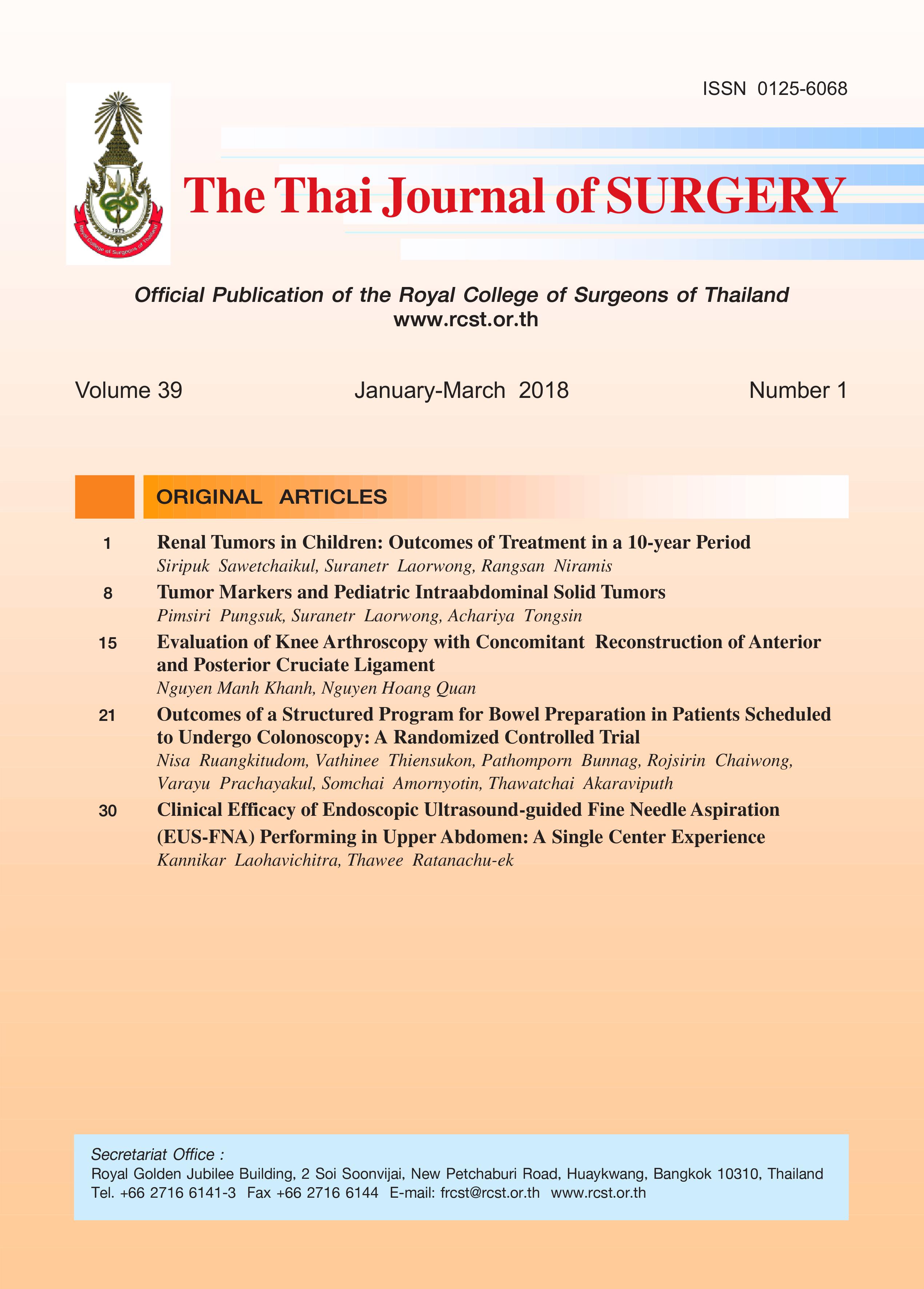Clinical Efficacy of Endoscopic Ultrasound-guided Fine Needle Aspiration (EUS-FNA) Performing in Upper Abdomen: A Single Center Experience
Keywords:
Endoscopic ultrasound, fine needle aspiration, efficacy, EUS-FNAAbstract
Background: Endoscopic ultrasound with fine needle aspiration (EUS-FNA) is a useful procedure for the evaluation and tissue acquisition of lesions located in organs close to the upper gastrointestinal tract, such as the pancreas, periceliac lymph nodes, aortocaval lymph nodes, left lobe of liver, bile duct, retroperitoneal masses or lesions located in the wall of upper gastrointestinal tract itself, and also masses located in mediastinum. EUS-FNA can provide tissue samples for cytological or pathological analysis that is helpful for the diagnosis, tumor staging, and management of many surgical conditions. The authors conducted the present study to evaluate the accuracy of EUS-FNA performed at Rajavithi Hospital.
Objective: To evaluate the results of diagnostic accuracy, sensitivity, specificity, positive predictive value and negative predictive value of EUS-FNA performed at a tertiary gastrointestinal endoscopic center of the Department of Surgery, Rajavithi Hospital.
Material and method: The authors retrospectively reviewed the EUS-FNA database obtained between October 2014 and September 2016. Data obtained, including demographics, organ of examination, results of cytological and/or pathological reports, size of the needles and follow-up data, were analyzed and reported.
Results: EUS-FNA was performed in 172 patients (90 males, 82 females), with a mean age of 54.8 years (range 17-89 years). The overall diagnostic accuracy was 91.9%, with a sensitivity of 88.1%, specificity of 100%, positive predictive value (PPV) of 100% and negative predictive value (NPV) of 81.8%. Patients were divided into four groups according to anatomical location, i.e., pancreas, stomach, lymph nodes and other locations. The majority of the EUS-FNA was performed on the pancreas, which included 124 patients. There were 15 patients with stomach lesions, 19 with lymphadenopathy and 14 with other lesions. The sensitivity of EUS-FNA for each group varied from 84.6% to 93.7%. The specificity was 100% for every group due to no false positive result, and the accuracy ranged from 86.7 to 94.7%. No serious complications occurred in all patients.
Conclusion: EUS-FNA performed at the Gastrointestinal Endoscopic Center, Department of Surgery, Rajavithi Hospital, is a safe and accurate diagnostic procedure which is very useful for management planning.
References
2. Dumoceau JM, Polkowski M, Larghi A, Wilmann P, Giovannini M, Frossard JL, et al. Indications, results, and clinical impact of endoscopic ultrasound (EUS)-guided sampling in gastroenterology: European Society of Gastrointestinal Endoscopy (ESGE) Clinical Guideline. Endoscopy 2011; 43:897-909.
3. Chen G, Liu S, Zhao Y, Dai M, Zhang T. Diagnostic accuracy of endoscopic ultrasound-guided fine-neeedle aspiration for pancreatic cancer. A meta-analysis. Pancreatology 2013;13:298-304.
4. Houshang A, Alizadeh M, Shahrokh S, Hadizadeh M, Padashi M, Zali MR. Diagnostic potency of EUS-guided FNA for the evaluation of pancreatic mass lesions. Endosc Ultrasound 2016;5(1):30-4.
5. Eloubeidi MA, Jhala D, Chheing DC, Chen VK, Eltoum I, Vickers S, et al. Yield of endoscopic ultrasound-guided fineneedle aspiration biopsy in patients with suspected pancreatic carcinoma. Cancer 2003;99:285-92.
6. Wiersema MJ, Vilmann P, Giovannini M, Chang KJ, Weirsema LM. Endosonography-guided fine-needle aspiration biopsy: diagnostic accuracy and complication assessment. Gastroenterology 1997;112:1087-95.
7. Webb K, Hwang JH. Endoscopic ultrasound-fine needle aspiration versus core biopsy for the diagnosis of subepithelial tumors. Clin Endosc 2013;46:441-4.
8. Okasha HH, Naguib M, Nady ME, Ezzat R, Gemeie EA, Nabawy WA, et al. Role of endoscopic ultrasound and endoscopic-ultrasound-guided fine-needle aspiration in endoscopic biopsy negative gastrointestinal lesions. Endoscopic Ultrasound 2017;6:156-61.
9. Jorenblit J, Anantharaman A, Loren DE, Kowalski TE, Siddiqui AA. The role of endosopicuitrasound-guided fine needle aspiration (eus-fna) for the diagnosis of intra-abdominal lymphadenopathy of unknown origin. J Interv Gastroenterol 2012;2:172-6.
10. Dhir V, Mathew P, Bhandari S, Kwek A, Doctor V, Maydeo A.Endosonography-guided fine needle aspiration cytology of intra-abdominal lymph nodes with unknown primary in a tuberculosios endemic region. J Gastroenterol Hepatol 2011;26(12):1721-4.
11. Korenblit J, Anantharaman A, Loren DE, Kowalski TE, Siddiqui AA. The role of endoscopic ultrasound-guided fine needle aspiration (eus-fna) for the diagnosis of intra-abdominal lymphadenopathy of unknown origin. J Interv Gastroenterol 2012;2(4):172-6.
12. Yasuda I, Tsurumi H, Omar S, Iwashita T, Kojima Y, Yamada T, et al. Endoscopic ultrasound-guided fine-needle aspiration biopsy for lymphadenopathy of unknown origin. Endoscopy 2006;38(9):919-24.
13. Early DS, Acosta RD, Chandrasekhara V, Chathadi KV, Decker GA, Evans JA, et al. (ASGE STANDARDS OF PRACTICE COMMITTEE). Adverse events associated with EUS and EUS with FNA. Gastrointest Endosc 2013;77:839-43.
14. Yang SS, Liao SC, Ko CW, Tung CF, Peng YC, Lien HC, et al, The clinical efficacy and safety of EUS-FNA for diagnosis of mediastinal and abdominal solid tumors-A single center experience. Advances in Digestive Medicine 2015;2:61-6.
Downloads
Published
How to Cite
Issue
Section
License
Articles must be contributed solely to The Thai Journal of Surgery and when published become the property of the Royal College of Surgeons of Thailand. The Royal College of Surgeons of Thailand reserves copyright on all published materials and such materials may not be reproduced in any form without the written permission.



